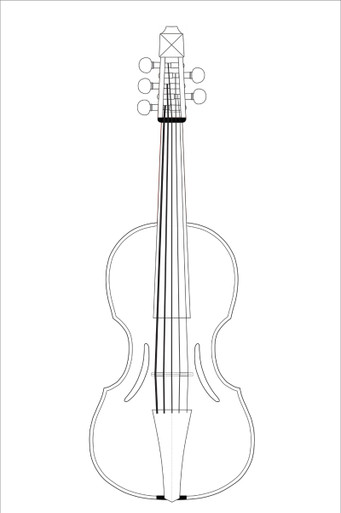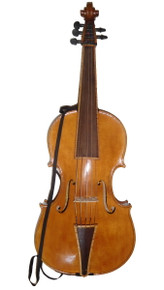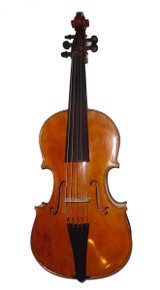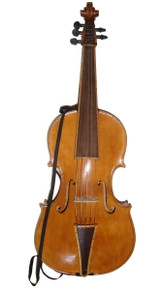Categories
Categories
- Home
- Baroque Instruments (including pochettes)
- Violoncello da Spalla Artist Master-Built Model by D. Rickert
Violoncello da Spalla Artist Master-Built Model by D. Rickert
Violoncello da Spalla Artist Master-Built Model by D. Rickert
Product Description
Please contact us if you wish to discuss purchasing one of these fine instruments.
Our email is don@DonRickertDesign.com and phone number is (706) 896-0909 or (706) 400-1481 (mobile). You can also use the "Contact" link on this page.
The Violoncello da Spalla, Artist Master-Built model is my newest and most ambitious instrument to date. It is also the most expensive. While it has a very vintage Baroque Period look, it is, in reality, one of my most technologically advanced instruments so far. I will get to this in a bit.
See and hear some demonstrations of our Violoncellos da Spalla.
The demonstrations below are but two of a large and growing number that can be seen and heard on our Violoncello da Spalla Demo Page.
The incredible Andrew Gonzalez performing on our Violoncello da Spalla by Don Rickert.
Heifetz 2018: Violoncello da spalla | Andrew Gonzalez Plays Bach
Bach 6th Suite Gigue on Violoncello da Spalla
As stated above, my new Violoncello da Spalla Artist Master-Built model is a departure from “traditional” violoncellos da spalla made by me and other top luthiers. It has more the look of some “descant viols”, one-off hybrid cello-viols and other plausibly similarly-tuned instruments, which pre-dated and co-existed with the original violoncellos da spalla. Note that they were NOT called that back in the 18th Century.
For my new Artist Violoncello da Spalla, I started fresh with a blank page (i.e. CAD drawings) rather than simply tweaking what I had designed in the past, or referring to any other existing plan. My first priority was extraordinary balanced sonority, tone and projection volume. While, admittedly, I was also striving for distinctiveness, I was not consciously going for an instrument with a minimalist modern look nor an instrument that looks vaguely ancient. I believe that my new Violoncello da Spalla looks both new and old at the same time. Whether or not you agree with this, it is undeniably distinctive. And its sound will amaze players and audiences for everything from historically-informed Baroque performance to Celtic, World and Traditional Folk genres. Artist Master-Built Violoncello da Spalla has a place in all of these genres
The body
As stated above, my new Violoncello da Spalla model looks quite different. It’s body and Chanot-style sound holes are very much inspired by early examples of Joseph Curtin’s revolutionary “Ultralight” Violin. Not the experimental construction of the “Ultralight”, such as composite construction utilizing balsa, just the form factor.
If you are not familiar with Joseph Curtin, he is regarded by most as one of the best, if not the best, living violin makers. He is also widely-regarded by some as one the best violin makers ever! He is also a very kind and generous person! See: Luthier Joseph Curtin Leads the Violin World’s Politest Revolution (Strings Magazine, October, 2017)
Essentially, my new instruments are sort of in-between (not quite a hybrid) a regular violin shape, with its acute corner blocks, and a “cornerless” (aka “guitar-shaped”) violin that is often associated with Francois Chanot in the early 19th Century, and also the “Cradle of Harmony” violin patented by William Sidney Mount in 1852(?). See my article, ‘The William Sidney Mount Historic 1852 “Cradle of Harmony” Violin’.
Mount’s Cradle of Harmony was, in fact, the inspiration for my first professional performance octave violins more than 15 years ago, played and evaluated by Darol Anger and Mikael Marin (ofVasen) prior to shipping to their present owners, Alasdair Fraser and Natalie Haas. See: Octave Violins, Octave Violas and Hybrids from Don Rickert Musical Instruments.
The Neck and “Scroll”
The “scroll” on my newest instrument models is not really a scroll, so it should really be called the “head” or “headstock”. My new headstock is inspired by many late Renaissance and early Baroque Period string instruments, particularly citterns and some viols. It is also similar to the “hook and shield” headstocks that Stradivari used on many of his instruments, particularly violas d’amore.
The necks are not carved from a single block; rather, they are “constructed” from multiple pieces of maple in much the same manner as the composite necks of many of the finest guitars, notably the incredible archtop guitars by Robert Benedetto. The composite construction makes for a much stronger and stable neck. It also makes installation of the neck angle adjustment mechanism easier, which is described below.
Not just a matter of style
While the design of the neck and “scroll” is largely a stylistic statement, the body design is not completely about style.
The overall form factor of my new top-of-the-line Artis Violoncello da Spalla is not simply a matter of style, although its distinctive look was a design criterion. The almost viol-like shape with “gentler” (i.e., obtuse) corners is designed to be somewhat less stiff than a standard violin shape. The sound holes are designed to achieve just the right Helmholtz resonance. The goal is even greater sonority and full-bodied tone than previous instruments, mine or anyone else’s. While having power, projection and tone closer to that of a modern full-size cello, it is will be very much a Violoncello da Spalla sonically. Those who are familiar with the violoncello da spalla know that its sonority and tone is unique and distinct from a large cello.
If the adventurous first customer for my new Violoncello da Spalla model is not overwhelmed with joy, I will replace it with a my most deluxe traditional Violoncello da Spalla. There is no escaping the fact that somebody has to be the first. Andrew Gonzalez was the first buyer of my Violoncello da Spalla Standard Model and he continues to play it in performances.
[insert image of Andrew G about here]
Other Exciting Features and Attributes
I have pulled out all of the stops when it comes to incorporating innovative sound enhancement technologies. All of these innovations are heard but not readily visible. High-level summaries appear below. Detailed descriptions of each will be published soon.
Sound post
The Artist Violoncello da Spalla will be fitted with sound post of my own design that has an adjustable height, with self-adjusting feet. I will post an article very soon with more details on the sound post, including the rationale.
End pin/button
My new Violoncello da Spalla model has a hollow aluminum alloy end button. One hears claims that the alloy vibrates in such a way as to improve tone. Also, the hole in the button supposedly improves the Helmholtz resonance (essentially the part of the sound that emanates from the sound holes).
I have no idea whether or not the above claims are true. The reason I use a hollow end button is to allow a luthier (e.g., me) to get a good view of the sound post when adjusting its height and location without having to remove the strings and tailpiece. The adjustable nature of the soundpost makes true optimization for tone truly possible.
Bass bar
The new Violoncello da Spalla Artist Master-Built model has a unique bass bar design, the result of my many years of experience building best-in-class violoncellos da spalla, as well as my other extended range instruments; octave violins, 5-string violins and 6-string violins.
Adjustable neck
My new Violoncello da Spalla can be built with either a traditional mortised set neck or a neck that is adjustable in both the X and Y (i.e., angle and centeredness) dimensions. I will have a whole lot more to say about this in a separate post.
Tuning pegs
The default is Wittner FineTune™ internally-geared pegs. Traditional pegs are an option as well.
Conclusion
I very much look forward to questions and inquiries.
Contact Info.
- Don Rickert on Linktree: https://linktr.ee/donrickert. This link gets you to ALL of my detailed contact information, my websites and social media.
- Email: doctorfiddle@gmail.com
- Phone (in US): 706-896-0909 or 706-400-1481 (mobile)
 Loading... Please wait...
Loading... Please wait... 








